Choosing the Right Pond Light and other Pond Lighting Tips
Our ponds and water features bring us all so much joy. Observing the fish and aquatic plants can add a level of tranquility to our outdoor spaces. It makes sense why so many look for solutions to extend the enjoyment their pond brings them into the evening hours.
Low voltage submersible pond lights are a popular solution to help make your pond sparkle at night. However, with a market flooded with so many landscape lighting products to choose from, making an informed decision about which kind of fixture is best for your pond can be intimidating.
There are three things to consider when choosing a submersible fixture to place in your pond: longevity, lighting effect, and (most important) the safety of your fish. Lets get into it!
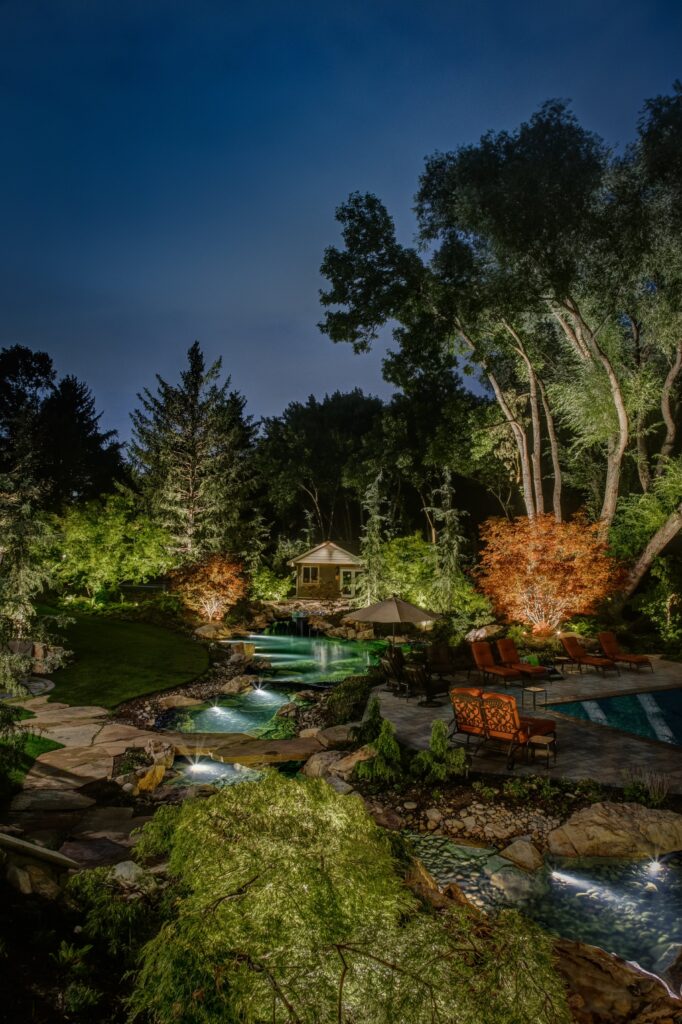
Fixture Longevity
Your fixture’s ability to stand up to the test of time is crucial. Why spend the money on a fixture that isn’t going to deliver a lifetime of performance?
I hate to be the bearer of bad news, but there is next to no such thing as a 100% bullet proof underwater fixture. All submersible fixtures are susceptible to potential leaks. However, the likelihood of a leak ever occurring can be greatly reduced depending on how the fixture is built and engineered.
First off, consider what kind of material the fixture is built from. Some materials work well for short term solutions, but tend to experience failures more often, and more quickly.
Composite and Ceramic
While composite (hard plastic) and ceramic fixtures tend to be more affordable, they also tend to be more failure prone. The plastic housing can crack from temperature fluctuations and be damaged by UV rays if the fixtures is only partially submerged. Below is an example of two failed composite fixtures that had to be replaced.
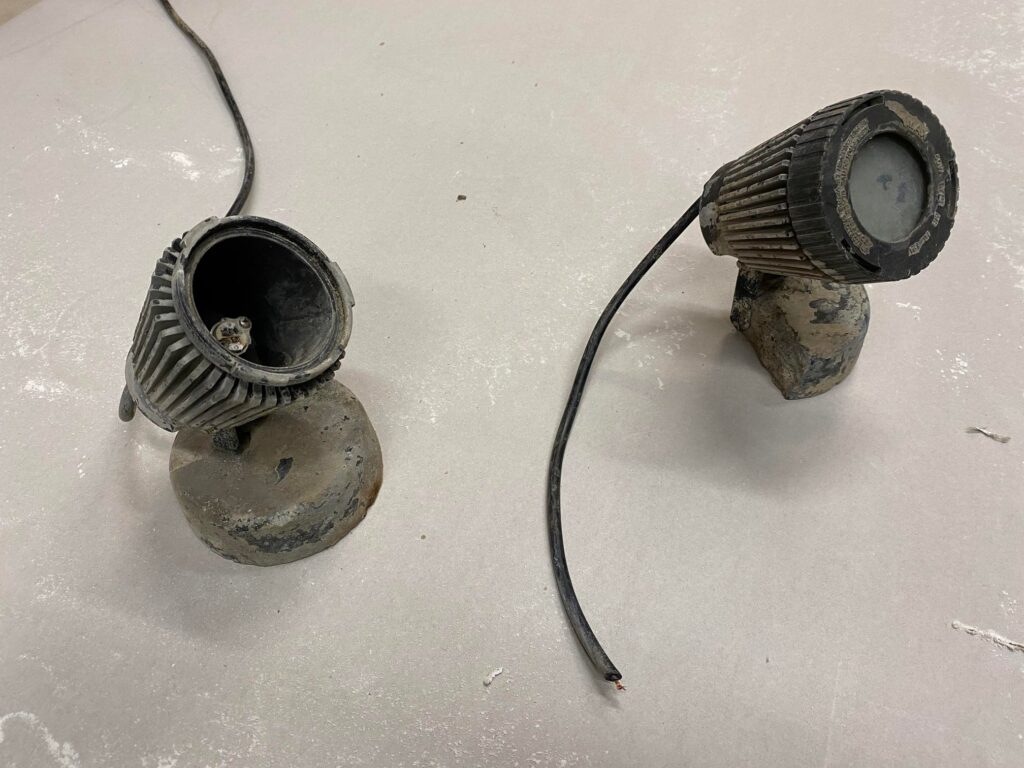
Aluminum
While not seen quite as often, underwater aluminum fixtures are out there. The problem with using a material like aluminum for an underwater light is that aluminum is a ferrous metal. Simply put, ferrous metals are susceptible to corrosion.
Most aluminum fixtures go through a special treatment process during manufacturing to protect against corrosion. Powder coating, for example, is one method used on aluminum fixtures to protect them against corrosion.
However, even the smallest abrasion or nick on the powder coated surface can leave an aluminum fixture susceptible to corrosion. Once a fixture begins to corrode, the integrity is compromised and it will continue to slowly deteriorate.
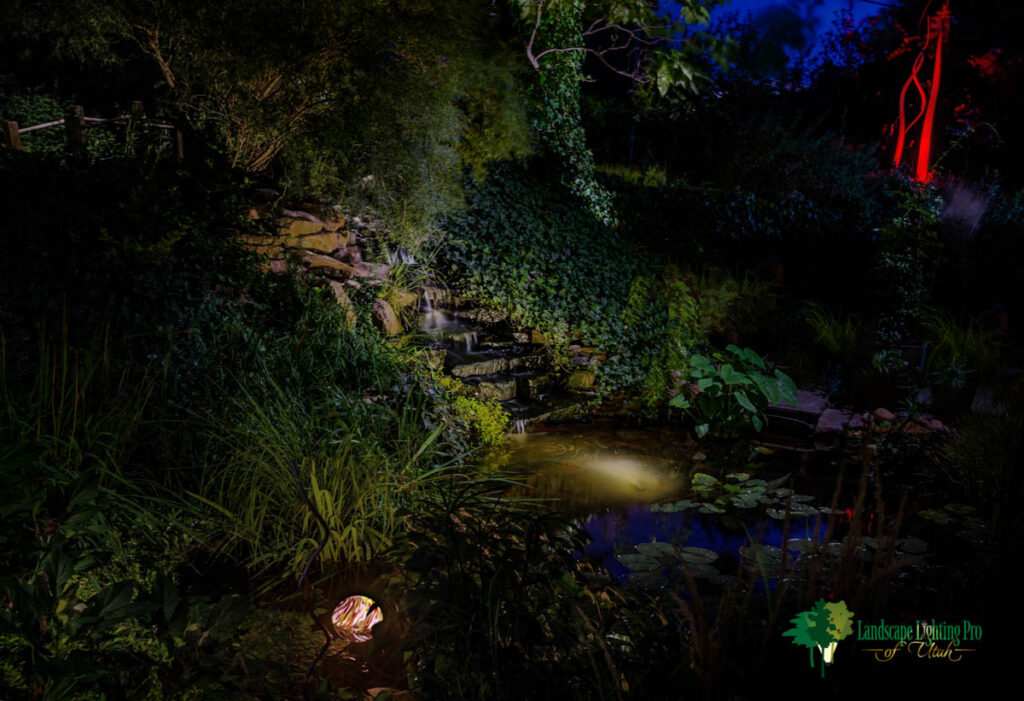
Stainless Steel
Even though stainless steel is considered a ferrous metal, it is highly resistant to corrosion. Stainless steel is an iron alloy containing chromium which keeps iron from rusting.
So long as the fixture is well engineered with tight fitting gaskets to keep water from entering the housing, a stainless steel fixture is a great option for keeping your pond lit for the years to come.
Brass
Brass is a non ferrous alloy. This means that it will not rust or corrode, period. Brass’ inability to corrode is the reason why its selected for marine applications; the harshest environment for long term durability. Brass is by far the most durable option when selecting a submersible fixture.
Below is an image of a discreet brass fixture that can be placed strategically between rocks or other places where it will be hidden from view. With lighting, its all about seeing the effect, not the source.
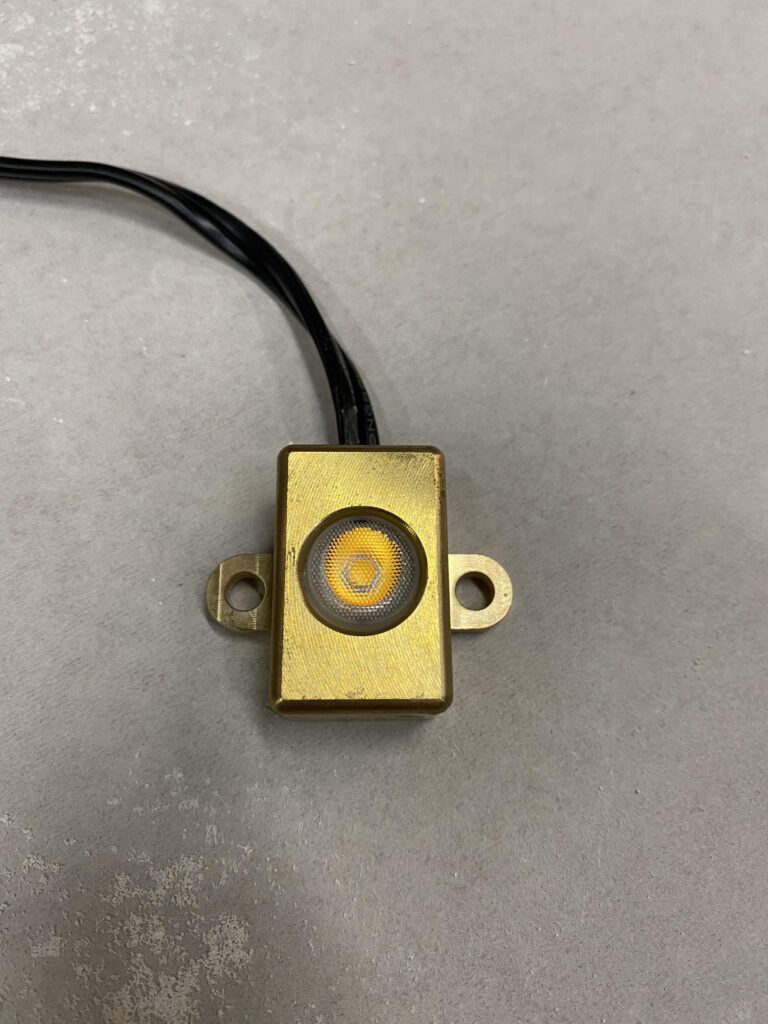
Pro Lighting Tip: Its worth noting that underwater fixtures are built and engineered to remain underwater. Over time, when an underwater fixture is allowed to dry out, then be re-submerged repeatedly, it can wear out the gaskets and other water proofing components over an extended period.
This can eventually lead to leaks from failing seals. If you are looking to add an underwater light to your pond or water feature, be sure its located in a place where it will remain underwater all year round.
Lighting Effects
Landscape lighting does more than simply illuminate our properties at night. Proper lighting provides us with a real sense of serenity. Light creates an inviting warmth, a sense of ambiance, and a feeling of security.
The affect lighting has on us and our state of mind is entirely dependent on the lighting effect. When it comes to pond lighting, the old saying “less is more” couldn’t be more true. You don’t want your pond to be seen from space. Soft, warmly toned lighting levels should be our goal. That said, there are three key components to consider when lighting your pond: Design, Kelvin temperature, and beam angle.
Design
We like to say that we design with light, not fixtures. This simply means that when we are looking at lighting a space, we should be thinking about what we would like to see illuminated and what kind of lighting effect it should have. The fixture selection ought to be more of an after thought. When you’re focused on the fixture you want to use, you’re not thinking about how to light the space.
When considering lighting for your pond, don’t just think about underwater lighting. First, ask yourself what you want to see lit and why:
- What is the best approach for casting light on my water fall?
- Did I consider lighting for the bridge that passes over my stream?
Don’t get tunnel vision. Ask yourself questions about lighting the things that make up your pond’s entirety, not only the water.
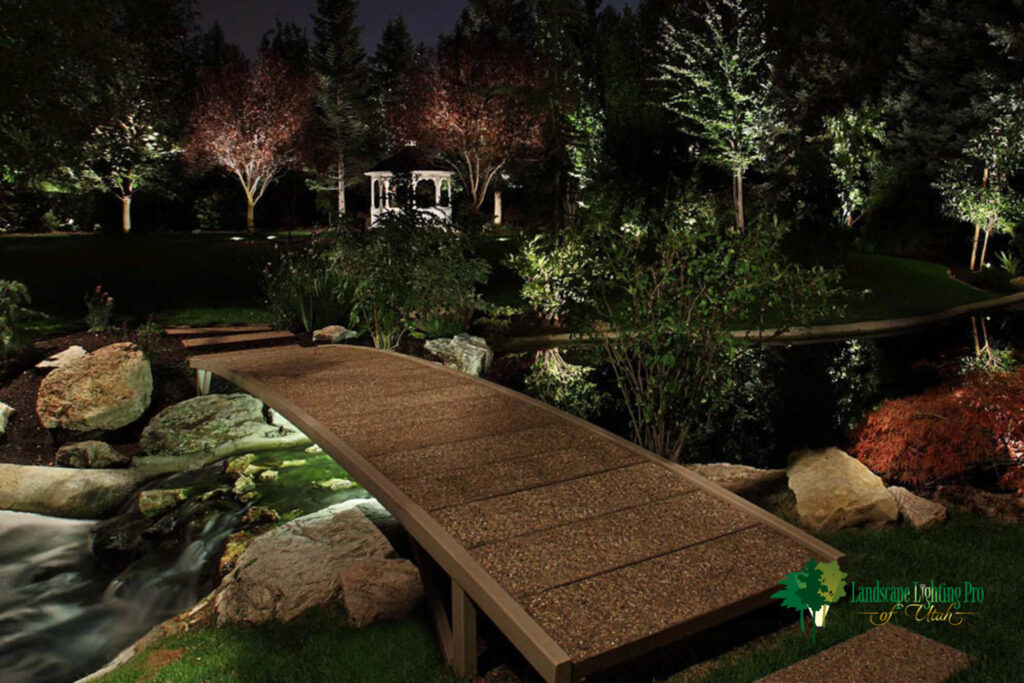
In the pond lit below, we can see how there is only one underwater light shinning up onto the small waterfall to the left. Rather than light the pond with underwater lights, we chose to focus on accenting the plant material with a technique called down lighting. Throwing a soft wash of light over the water lilies, decorative grasses, hostas, and other plants, created a backdrop to frame the ponds shoreline.
Lighting the pond this way provides us with greater visual control over our surroundings and helps keep our eyes from focusing on any one object. Having the pond mostly dark dark here creates contrast. The contrast between the light and shadows necessitates the drama that pulls us into the scene visually.
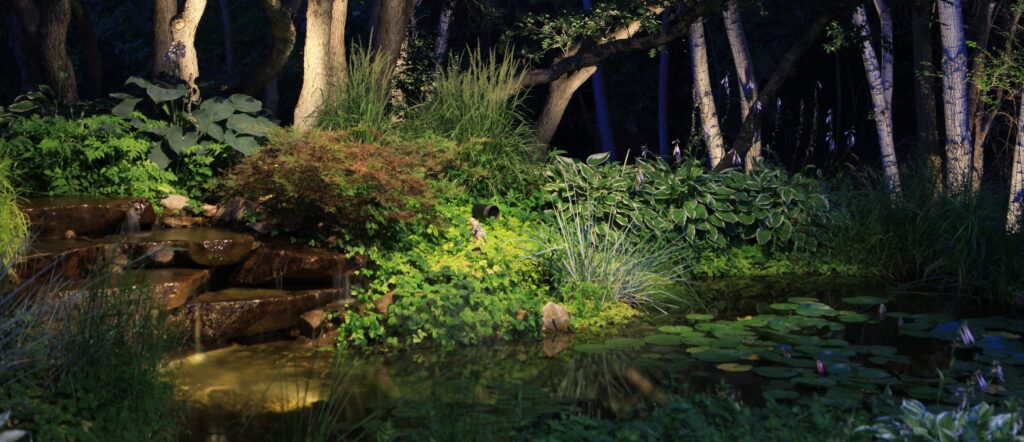
Kelvin Temperature
When we refer to kelvin temperature (to learn more about kelvin temperature, click here), we are simply referring to the character of the light and how it feels in terms of color. We’ve all experienced the dichotomy between the cooler feeling lights in a doctors office vs. the warmer feeling lights in restaurants.
Selecting the right color temperature for your pond can truly make all the difference in terms of how you experience your lighting on a psychological level. To experience your outdoor space with a warm comfortable feel, 2700K – 3000K is highly recommended.
Be mindful of your koi’s coloration when selection a kelvin temperature. If you have white koi in your pond, you may want to consider a slightly cooler color temperature. If the underwater lights shining on your koi are too warm (2200K) your white koi’s coloration can look dulled and off white or yellow.
If you want your white koi’s coloration to be more crisp, be sure the kelvin temperature shinning on them is between 2700K and 3500K. Avoid going any cooler than 3500K unless you want your koi to look like ghostly apparitions.
Beam Angle
If your lighting a waterfall or other object outside the body of water with a submerged underwater light, remember that the light will refract. The light being projected from underwater will bend. If we’re trying to light a waterfall with a submerged fixture, we aim the light at the base of the fall because the light refraction will cause the beam of light to bend upward and hit the waterfall in the center.
Fish Well-Being and Peace of Mind
The safety of your fish should take precedence over any lighting aesthetics. Quickly, lets go over lighting with your fish’s well being in mind.
Copper Fixtures
Copper fixtures should under no circumstance ever be used as a submerged light fixture. While copper is a nonferrous alloy like brass, the major difference is that copper will leach into the water and hurt or kill koi, gold fish, trout, bluegill, or any other kind of fish you’d see in a pond
Copper is toxic to our fish and will hurt them. In small doses, copper is used in fish medications to treat fish illnesses like ick, but the presence of a copper fixture will kill them. We can’t say this enough, do not place copper in your pond.
Sleepy Time
Your pond lights don’t need to keep your fish up all night. Lighting systems can be set up with different on/off functions. Your underwater pond lights can be set on a timer so they only run from sunset to midnight.
They can also be controlled by a simple on/off switch. When you step out in the evening to check on or enjoy your fish, you can turn the lights on with the flip of a switch. Then when your done, simply turn the lights off and send them to bed.
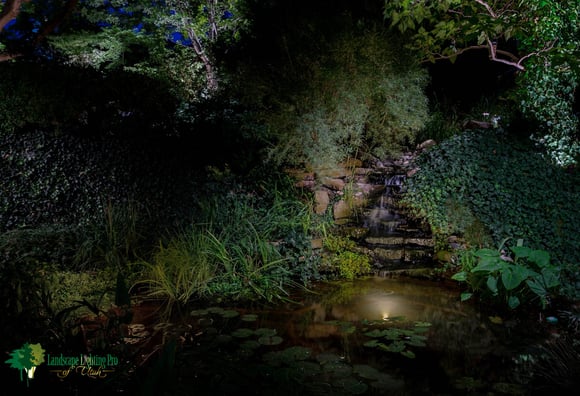
Conclusion
Don’t feel intimidated if your not sure where to start. Adding lighting to your pond can be a lot of fun. The best thing you can do if your not sure where to get started is to simply go out at night and experiment.
Where does it feel dark around the backyard? Is task lighting needed for a trip hazard between your backdoor and your pond? Where do you enjoy spending the most time around your pond? Thinking about these things can help you figure out where to get started.
Next, grab a flashlight and start experimenting to see how different features look when they are lit. Be sure not to submerge your flashlight unless its water proof!
Landscape Lighting Makes All the Difference
At Landscape Lighting Pro of Utah, the art of outdoor illumination is a real passion we work to perfect. Designing elegantly bespoke landscape lighting systems is simply all we do. For over 15 years, our award winning team of designers and craftsmen have striven to bring the best outdoor lighting experience possible to people’s homes and businesses across the Wasatch front and beyond.
If you have an upcoming project you’d like help with, call us at (801)440-7647 for more information, schedule a free consultation, or feel free to simply fill out a contact form on our website.
Located in Midvale, Landscape Lighting Pro of Utah installs, maintains, and repairs lighting systems throughout Utah’s residential areas, including Salt Lake City, Park City, Draper, Davis & Utah Counties.
Salt Lake City (Midvale)
801-440-7647
St. George
435-932-6627
©2025 Landscape Lighting Pro
Privacy Policy
Cookie Policy